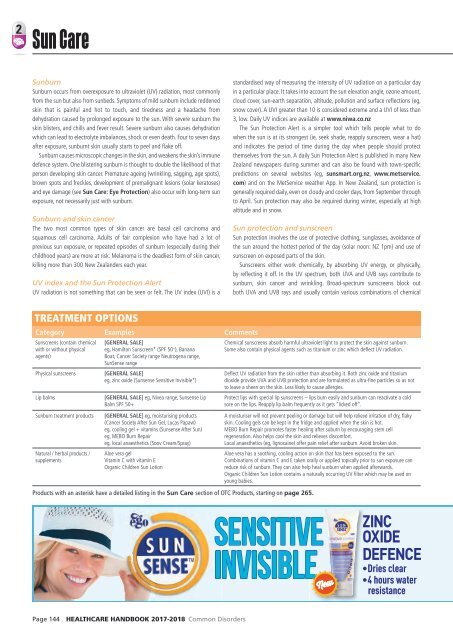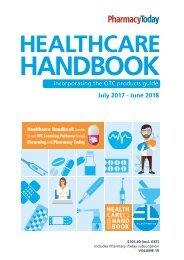2017 HCHB_digital
You also want an ePaper? Increase the reach of your titles
YUMPU automatically turns print PDFs into web optimized ePapers that Google loves.
Sun Care<br />
Sunburn<br />
Sunburn occurs from overexposure to ultraviolet (UV) radiation, most commonly<br />
from the sun but also from sunbeds. Symptoms of mild sunburn include reddened<br />
skin that is painful and hot to touch, and tiredness and a headache from<br />
dehydration caused by prolonged exposure to the sun. With severe sunburn the<br />
skin blisters, and chills and fever result. Severe sunburn also causes dehydration<br />
which can lead to electrolyte imbalances, shock or even death. Four to seven days<br />
after exposure, sunburnt skin usually starts to peel and flake off.<br />
Sunburn causes microscopic changes in the skin, and weakens the skin’s immune<br />
defence system. One blistering sunburn is thought to double the likelihood of that<br />
person developing skin cancer. Premature ageing (wrinkling, sagging, age spots),<br />
brown spots and freckles, development of premalignant lesions (solar keratoses)<br />
and eye damage (see Sun Care: Eye Protection) also occur with long-term sun<br />
exposure, not necessarily just with sunburn.<br />
Sunburn and skin cancer<br />
The two most common types of skin cancer are basal cell carcinoma and<br />
squamous cell carcinoma. Adults of fair complexion who have had a lot of<br />
previous sun exposure, or repeated episodes of sunburn (especially during their<br />
childhood years) are more at risk. Melanoma is the deadliest form of skin cancer,<br />
killing more than 300 New Zealanders each year.<br />
UV index and the Sun Protection Alert<br />
UV radiation is not something that can be seen or felt. The UV index (UVI) is a<br />
standardised way of measuring the intensity of UV radiation on a particular day<br />
in a particular place. It takes into account the sun elevation angle, ozone amount,<br />
cloud cover, sun-earth separation, altitude, pollution and surface reflections (eg,<br />
snow cover). A UVI greater than 10 is considered extreme and a UVI of less than<br />
3, low. Daily UV indices are available at www.niwa.co.nz<br />
The Sun Protection Alert is a simpler tool which tells people what to do<br />
when the sun is at its strongest (ie, seek shade, reapply sunscreen, wear a hat)<br />
and indicates the period of time during the day when people should protect<br />
themselves from the sun. A daily Sun Protection Alert is published in many New<br />
Zealand newspapers during summer and can also be found with town-specific<br />
predictions on several websites (eg, sunsmart.org.nz, www.metservice.<br />
com) and on the MetService weather App. In New Zealand, sun protection is<br />
generally required daily, even on cloudy and cooler days, from September through<br />
to April. Sun protection may also be required during winter, especially at high<br />
altitude and in snow.<br />
Sun protection and sunscreen<br />
Sun protection involves the use of protective clothing, sunglasses, avoidance of<br />
the sun around the hottest period of the day (solar noon: NZ 1pm) and use of<br />
sunscreen on exposed parts of the skin.<br />
Sunscreens either work chemically, by absorbing UV energy, or physically,<br />
by reflecting it off. In the UV spectrum, both UVA and UVB rays contribute to<br />
sunburn, skin cancer and wrinkling. Broad-spectrum sunscreens block out<br />
both UVA and UVB rays and usually contain various combinations of chemical<br />
TREATMENT OPTIONS<br />
Category Examples Comments<br />
Sunscreens (contain chemical<br />
with or without physical<br />
agents)<br />
Physical sunscreens<br />
Lip balms<br />
Sunburn treatment products<br />
Natural / herbal products /<br />
supplements<br />
[GENERAL SALE]<br />
eg, Hamilton Sunscreen* (SPF 50 + ), Banana<br />
Boat, Cancer Society range Neutrogena range,<br />
SunSense range<br />
[GENERAL SALE]<br />
eg, zinc oxide (Sunsense Sensitive Invisible*)<br />
[GENERAL SALE] eg, Nivea range, Sunsense Lip<br />
Balm SPF 50+<br />
[GENERAL SALE] eg, moisturising products<br />
(Cancer Society After Sun Gel, Lucas Papaw)<br />
eg, cooling gel + vitamins (Sunsense After Sun)<br />
eg, MEBO Burn Repair<br />
eg, local anaesthetics (Soov Cream/Spray)<br />
Aloe vera gel<br />
Vitamin C with vitamin E<br />
Organic Children Sun Lotion<br />
Products with an asterisk have a detailed listing in the Sun Care section of OTC Products, starting on page 265.<br />
Chemical sunscreens absorb harmful ultraviolet light to protect the skin against sunburn.<br />
Some also contain physical agents such as titanium or zinc which deflect UV radiation.<br />
Deflect UV radiation from the skin rather than absorbing it. Both zinc oxide and titanium<br />
dioxide provide UVA and UVB protection and are formulated as ultra-fine particles so as not<br />
to leave a sheen on the skin. Less likely to cause allergies.<br />
Protect lips with special lip sunscreens – lips burn easily and sunburn can reactivate a cold<br />
sore on the lips. Reapply lip balm frequently as it gets “licked off”.<br />
A moisturiser will not prevent peeling or damage but will help relieve irritation of dry, flaky<br />
skin. Cooling gels can be kept in the fridge and applied when the skin is hot.<br />
MEBO Burn Repair promotes faster healing after suburn by encouraging stem cell<br />
regeneration. Also helps cool the skin and relieves discomfort.<br />
Local anaesthetics (eg, lignocaine) offer pain relief after sunburn. Avoid broken skin.<br />
Aloe vera has a soothing, cooling action on skin that has been exposed to the sun.<br />
Combinations of vitamin C and E taken orally or applied topically prior to sun exposure can<br />
reduce risk of sunburn. They can also help heal sunburn when applied afterwards.<br />
Organic Children Sun Lotion contains a naturally occurring UV filter which may be used on<br />
young babies.<br />
SENSITIVE<br />
INVISIBLE<br />
ZINC<br />
OXIDE<br />
DEFENCE<br />
• Dries clear<br />
• 4 hours water<br />
resistance<br />
Page 144 HEALTHCARE HANDBOOK <strong>2017</strong>-2018 Common Disorders



